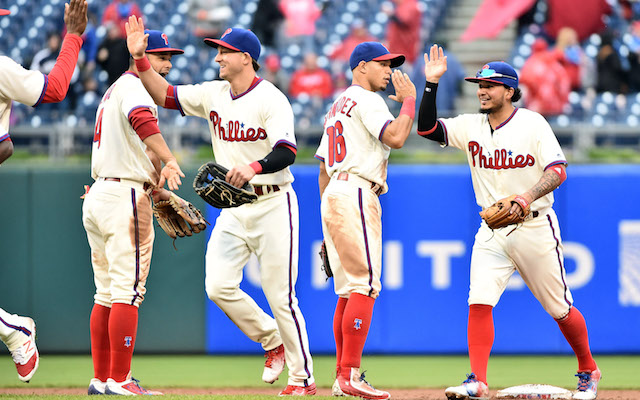The Phillies are baseball’s biggest surprise so far, can they keep it up? – CBSSports.com
The Phillies, by all appearances, are in rebuilding mode. They’ve traded off a number of veterans in recent months and presently have the youngest pitching staff and fifth-youngest roster of position players in the National League. They’re also coming off a 99-loss season in 2015.
True to form, the Phillies began 2016 with a 0-4 mark, which included a sweep at the similarly miserable hands of the Reds. Since then, though, the Phils have gone 15-6. As well, Sunday’s 2-1 win over Cleveland (box score) means they’ve notched back-to-back sweeps over the Nationals and Indians, both likely contenders. The compound question is thus raised: How have the Phillies surprised us thus far, and can they keep it up?
For the Phils, their success to date has been driven by the run-prevention side of things. At present, they rank fifth in the NL in fewest runs allowed, fifth in OPS allowed and ERA. More specifically, the Philly defense ranks fifth in the NL in defensive efficiency (i.e., the percentage of balls in play that a defensive converts into outs), and the rotation has been among the NL’s best. Said rotation is fourth in the NL in ERA and first by a substantial margin in K/BB ratio. As noted above, it’s also a very young rotation. Specially, Aaron Nola, Vincent Velasquez and Jerad Eickhoff should be core contributors for years to come. Making the best of their recent trades has gone a long way toward improving the young pitching in the system, and an apparent organization emphasis on the curveball also seems to be paying off.
There’s a downside, though, that should be addressed before we get to the other upside: The Phillies have been pretty lucky to date. They have a run differential of minus-16 on the year, and if you look beyond that to the level of their batted-ball outcomes, this looks more like a “true” losing team. So how have they outplayed those fundamentals? Well, they’re 8-2 in one-run games, which is almost certainly not going to keep up.
On the other hand, there’s nothing out of whack with their pitchers’ BABIP or strand rate or home runs as a percentage of fly balls — common indicators that regression is in the offing. It’s mostly the fact that they’re playing .800 ball in one-run games that should give pause to touters of the 2016 Phillies.
There’s of course another mid- to long-range consideration about this team. That is, more help is on the way. Already in place are those young starters and core position players like Maikel Franco and Odubel Herrera. On the way — almost certainly at some point this season — are top prospects like J.P. Crawford, Nick Williams, Jake Thompson, Mark Appel, Jorge Alfaro and Andrew Knapp, among others. (Let’s also not forget that the Phillies have the top overall pick in the June draft.)
As for the here and now, no, the Phillies aren’t likely to sustain this pace and contend in 2016. That said, there’s interesting young talent in place and much more on the way. As well, there’s a lot to be said for gearing up for the future, as the Phillies have done, while not bottoming out in humiliating fashion, as the Braves seem to be doing. It’s less emotionally taxing on the fan base — and the players themselves — to be respectable while still knowing that better days are likely ahead.
Playoff bound? Probably not. But the bright future in Philly may not be preceded by a wholly dark present. In an era in which there’s so much hand-wringing over “tanking,” isn’t that something?




